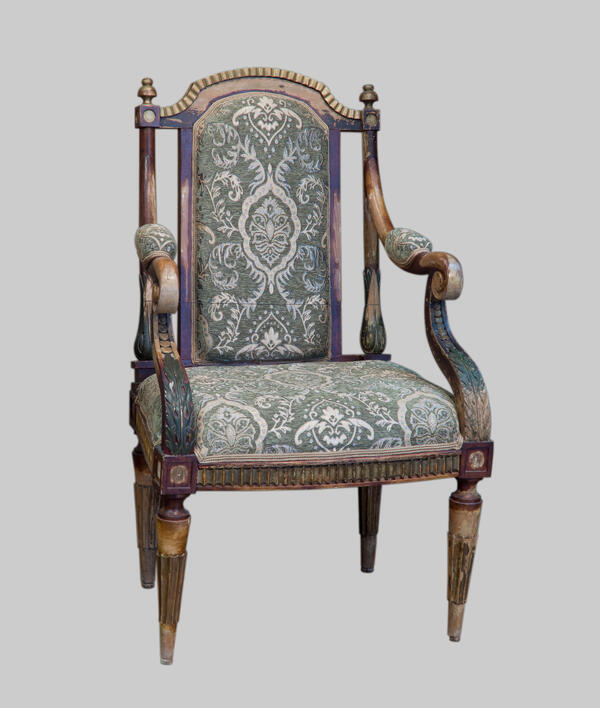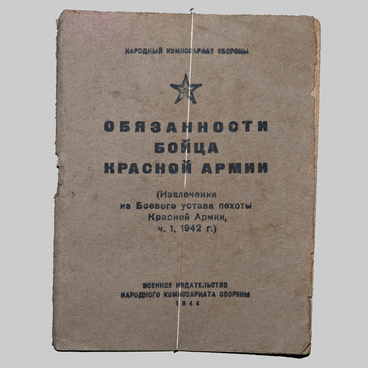The dilapidated armchair was discovered by architects-restorers in the basement of the Stroganov chambers in 1955. The exhibit was submitted to the Berezniki History and Art Museum in 2014. At the same time, the fine art restorer of the Perm Museum of Local History, Ilya Sidorov, restored the armchair. He reconstructed parts, restored carvings, reinforced the primer, reupholstered the seats and carried out other maintenance work.
The Stroganov, industrialist family, founded UsOlye in 1606 as the center of the salt industry. The Stroganov chambers, their residence in UsOlye, are an example of the so-called Moscow baroque of the late 17th - early 18th centuries.
Until the 16th century, an armchair was a rare occurrence in the Russian interiors. The decor of the house, whether it was chambers of a noble boyar or a plain peasant hut, was most often plain and functional. There were a large Russian stove in the middle of any room, and wide benches secured to the walls.
Chairs were used only by wealthy high-ranked people and that’s why they had a majestic appearance - a high carved back, reminiscent of a royal throne. An owner of a mansion had to have his place of honor.
Chairs and armchairs became fashionable during Peter the Great reign. Massive forms and plain design were inherent in the first chairs. In the second half of the 18th century, armchairs and chairs became more refined and elegant. Furniture of that time was an expensive pleasure: it was mainly brought from abroad.
The growth of furniture production in Russia began during the reign of Catherine II. Craftsmen from Germany, Italy, Poland, Switzerland opened their workshops in Moscow and St. Petersburg. Russian landowners taught their serfs to carpentry and furniture and set up furniture production in their provinces. The armchair in the collection of the Berezniki Museum also belongs to the late 18th - early 19th centuries.
In the Perm Territory Maslennikov and Trusov, the Solikamsk bourgeoisie, were the one who manufactured furniture - sofas and armchairs. Wicker chairs and armchairs popular at the beginning of the 20th century were made by many villagers. In 1907, a wicker furniture workshop was opened at the DedYUkhinsky men’s two-class school.
The Stroganov, industrialist family, founded UsOlye in 1606 as the center of the salt industry. The Stroganov chambers, their residence in UsOlye, are an example of the so-called Moscow baroque of the late 17th - early 18th centuries.
Until the 16th century, an armchair was a rare occurrence in the Russian interiors. The decor of the house, whether it was chambers of a noble boyar or a plain peasant hut, was most often plain and functional. There were a large Russian stove in the middle of any room, and wide benches secured to the walls.
Chairs were used only by wealthy high-ranked people and that’s why they had a majestic appearance - a high carved back, reminiscent of a royal throne. An owner of a mansion had to have his place of honor.
Chairs and armchairs became fashionable during Peter the Great reign. Massive forms and plain design were inherent in the first chairs. In the second half of the 18th century, armchairs and chairs became more refined and elegant. Furniture of that time was an expensive pleasure: it was mainly brought from abroad.
The growth of furniture production in Russia began during the reign of Catherine II. Craftsmen from Germany, Italy, Poland, Switzerland opened their workshops in Moscow and St. Petersburg. Russian landowners taught their serfs to carpentry and furniture and set up furniture production in their provinces. The armchair in the collection of the Berezniki Museum also belongs to the late 18th - early 19th centuries.
In the Perm Territory Maslennikov and Trusov, the Solikamsk bourgeoisie, were the one who manufactured furniture - sofas and armchairs. Wicker chairs and armchairs popular at the beginning of the 20th century were made by many villagers. In 1907, a wicker furniture workshop was opened at the DedYUkhinsky men’s two-class school.



